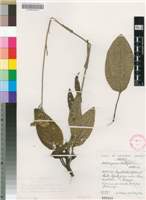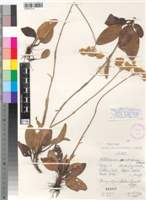Origin of name:
molli = softfolium = leaves
Diagnostic characters:
Large leaves with distinct veinsLarge headsOpen branched inflorescence
Description:
Perennial herb, roots with narrow fusiform tubers, stock small, producing slender rhizomes, flowering stem terminal, solitary, simple, 350�600 mm tall, with long multicellular hairs and thinly white-woolly as well, reduced leaves near base, distantly bracteate upwards. Leaves mostly radical, c. 4�6, petiole thin, wiry, c. 20�120 mm long, blade c. 30�120 x 25�50 mm, broadly elliptic to ovate-elliptic, soft-textured, apex obtuse to subacute, apiculate, base rounded or broadly cuneate, upper surface rough with long multicellular hairs, lower conspicuously 5-nerved, hairs best developed on nerves, elsewhere with shining yellow sessile glands, margins weakly revolute; cauline leaves similar but soon sessile and narrower, passing rapidly into few, distant acuminate bracts. Heads homogamous, campanulate, c. 5�6 x 4�5 mm, many in a loose or compact corymbose panicle. Involucral bracts in c. 4 series, slightly graded, loosely imbricate, about equaling flowers, bases loosely woolly, limb subopaque, slightly glossy, outer golden-brown, inner yellow, tips obtuse, slightly crisped, not radiating. Receptacle with fimbrils twice as long as ovaries. Flowers 19�30. Achenes not seen, ovaries glabrous. Pappus bristles many, scabrid, bases cohering strongly by patent cilia, lightly fused as well.
Flowering from November to February
Distribution:
Grows in moist grassy depressions running down the mountain slopes, along flats near streams, or on the damp margins of forest patches. Known from Royal Natal National Park, Bergville district, then the southern KwaZulu-Natal Drakensberg, from the great ridge running SE. from Giant's Castle south to Garden Castle Forest Reserve, at c. 2 100- 2 450 m.
Grassland Biome.
Notes:
Distinguished from H. miconiifolium by its flowering stem only remotely bracteate above, soft, 5-nerved leaves and blunt involucral bracts, and from H. nudifolium by its soft leaves crowded at the base of the stem and more golden and brown involucral bracts.Taxonomy:
Literature:
Helichrysum mollifolium Hilliard in Notes R. bot. Gdn Edinb. 40: 261 (1982).
Type:
KwaZulu-Natal, Underberg, distr., Cobham Forest Station, Upper Polela Cave area, c. 2 350 m, 16 ii 1979, Hilliard & Burtt 12611 (NU, holo.; E; K; PRE; S, iso.).
Synonym(s):
Vouchers:
Hilliard & Burtt 12555 (E; K; NU); Wright 407 (E; NU).

